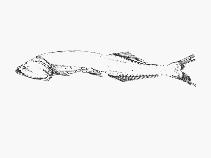http://www.fishbase.org/Summary/speciesSummary.php?genusname=Cyclothone&speciesname=pallida ---> http://192.134.151.83/Summary/speciesSummary.php?genusname=Cyclothone&speciesname=pallida
http://192.134.151.83/Summary/speciesSummary.php?genusname=Cyclothone&speciesname=pallida ---> https://fishbase.mnhn.fr/Summary/speciesSummary.php?genusname=Cyclothone&speciesname=pallida
https://fishbase.mnhn.fr/Summary/speciesSummary.php?genusname=Cyclothone&speciesname=pallida ---> https://fishbase.mnhn.fr/summary/Cyclothone-pallida.html
Cyclothone pallida, Tan bristlemouth

You can
sponsor
this page
Common name (e.g. trout)
Genus + Species (e.g. Gadus morhua)
-

-
About this page
-
Languages
-
User feedbacks
-
Citation
-
Uploads
-
Related species
-


 Tan bristlemouth
Add your observation in
Fish Watcher
Upload your
photos
and
videos
Tan bristlemouth
Add your observation in
Fish Watcher
Upload your
photos
and
videos
Pictures
|
Google image
 Cyclothone pallida
Cyclothone pallida
Picture by
SFSA
Teleostei (teleosts) >
Stomiiformes
(Lightfishes and dragonfishes) >
Gonostomatidae
(Bristlemouths)
Etymology:
Cyclothone:
Greek, kyklothen, in circle, around (Ref.
45335
)
.
Environment: milieu / climate zone / depth range / distribution range
Ecology
Marine; bathypelagic; depth range 16 - 4663 m (Ref.
58302
), usually 600 - 1800 m (Ref.
58302
). Deep-water; 61°N - 40°S, 180°W - 180°E
Atlantic, Indian and Pacific: in tropical to temperate waters. Southern Ocean: Indian Ocean sector south of Australia. South China Sea (Ref.74511).
Length at first maturity / Size / Weight / Age
Maturity: L
m
4.3
range ? - ? cm
Max length : 4.8 cm SL male/unsexed; (Ref.
5162
); 7.5 cm SL (female)
Dorsal
spines
(total): 0;
Dorsal
soft rays
(total): 12-15;
Anal
spines
: 0;
Anal
soft rays
: 16 - 19. Light to dark brown in color; transparent or slightly pigmented immediately anterior to anal and dorsal origin; median fin rays and internasal area pigmented; meningeal pigment extending to level of rear margin of eye (Ref.
3991
).
Meso- to bathypelagic (Ref.
58302
). Oceanic, precise depth range dependent upon developmental stage, latitude, season (Ref.
4769
). Does not exhibit diel vertical migrations (Ref.
4769
). Lipid content is 2.3 % in fresh body weight and wax ester is 34.0 % in total lipids (Ref.
9193
).
Life cycle and mating behavior
Maturity
|
Reproduction
|
Spawning
|
Eggs
|
Fecundity
|
Larvae
Gon, O.
, 1990. Gonostomatidae. p. 116-122. In O. Gon and P.C. Heemstra (eds.) Fishes of the Southern Ocean. J.L.B. Smith Institute of Ichthyology, Grahamstown, South Africa. 462 p. (Ref.
5162
)
IUCN Red List Status (Ref.
130435
)
Least Concern (LC)
; Date assessed:
16 May 2013
CITES
Not Evaluated
Not Evaluated
Threat to humans
Harmless
Human uses
Fisheries: of no interest
FAO - Publication:
search
|
FishSource
|
More information
Countries
FAO areas
Ecosystems
Occurrences
Introductions
Stocks
Ecology
Diet
Food items
Food consumption
Ration
Common names
Synonyms
Metabolism
Predators
Ecotoxicology
Reproduction
Maturity
Spawning
Spawning aggregation
Fecundity
Eggs
Egg development
Age/Size
Growth
Length-weight
Length-length
Length-frequencies
Morphometrics
Morphology
Larvae
Larval dynamics
Recruitment
Abundance
BRUVS
References
Aquaculture
Aquaculture profile
Strains
Genetics
Electrophoreses
Heritability
Diseases
Processing
Nutrients
Mass conversion
Collaborators
Pictures
Stamps, Coins Misc.
Sounds
Ciguatera
Speed
Swim. type
Gill area
Otoliths
Brains
Vision
Tools
E-book
|
Field guide
|
Length-frequency wizard
|
Life-history tool
|
Point map
|
Classification Tree
|
Catch-MSY
|
Special reports
Check for Aquarium maintenance
|
Check for Species Fact Sheets
|
Check for Aquaculture Fact Sheets
Download XML
Summary page
|
Point data
|
Common names
|
Photos
Internet sources
AFORO (otoliths)
|
Aquatic Commons
|
BHL
|
Cloffa
|
BOLDSystems
|
Websites from users
|
Check FishWatcher
|
CISTI
|
Catalog of Fishes
:
genus
,
species
|
DiscoverLife
|
ECOTOX
| FAO - Publication:
search
|
Faunafri
| Fishipedia |
Fishtrace
| GenBank:
genome
,
nucleotide
|
GloBI
|
Google Books
|
Google Scholar
|
Google
| IGFA World Record |
MitoFish
|
National databases
|
Otolith Atlas of Taiwan Fishes
|
PubMed
| Reef Life Survey | Socotra Atlas |
Tree of Life
| Wikipedia:
Go
,
Search
| World Records Freshwater Fishing |
Zoobank
|
Zoological Record
Estimates based on models
Preferred temperature (Ref.
123201
): 2.5 - 8.7, mean 4.2 °C (based on 3651 cells).
Phylogenetic diversity index (Ref.
82804
): PD
50
= 0.5001 [Uniqueness, from 0.5 = low to 2.0 = high].
Bayesian length-weight: a=0.00389 (0.00171 - 0.00885), b=2.99 (2.79 - 3.19), in cm total length, based on LWR estimates for this (Sub)family-body shape (Ref.
93245
).
Trophic level (Ref.
69278
): 3.2 ±0.36 se; based on food items.
Resilience (Ref.
120179
): Medium, minimum population doubling time 1.4 - 4.4 years (tm=3.5).
Fishing Vulnerability (Ref.
59153
): Low vulnerability (10 of 100).
Back to Search
Random Species
Back to Top
Accessed through:
Not available
FishBase mirror site :
localhost
Page last modified by :
mrius-barile
- 20 July 2016
Fatal error
: Uncaught ArgumentCountError: Too few arguments to function checkEcotox(), 1 passed in /var/www/html/summary/speciessummary.php on line 2304 and exactly 3 expected in /var/www/html/includes/speciessummary.lib.php:2579 Stack trace: #0 /var/www/html/summary/speciessummary.php(2304): checkEcotox() #1 {main} thrown in
/var/www/html/includes/speciessummary.lib.php
on line
2579
|